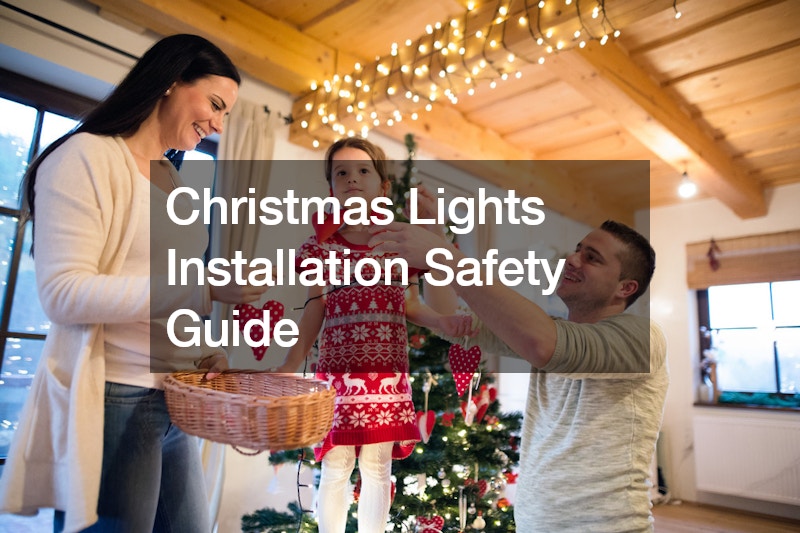

As the holiday season approaches, many homeowners are eager to adorn their houses with festive decorations, including Christmas lights. While the twinkling lights can create a beautiful display, it’s essential to prioritize safety during the installation process. From avoiding electrical hazards to preventing falls, here’s a comprehensive safety guide to ensure a merry and safe holiday season.
Plan Ahead:
Before beginning the installation process, it’s crucial to plan your lighting display thoroughly. Take note of where you want to hang the lights, paying attention to potential hazards such as overhead power lines or unstable surfaces.
Planning ahead can help you execute the installation more safely and efficiently.
Inspect Lights and Equipment:
Before hanging any lights, carefully inspect them for signs of damage or wear. Check for frayed wires, broken bulbs, or exposed connectors. It’s also essential to inspect your extension cords and electrical outlets for any damage. Avoid using damaged equipment, as it can pose a significant risk of electrical shock or fire.
Use Outdoor-Rated Lights:
When decorating the exterior of your home, make sure to use lights specifically designed for outdoor use. These lights are constructed to withstand exposure to the elements, reducing the risk of electrical hazards. Additionally, outdoor-rated lights are often more durable, making them a safer option for extended use.
Avoid Overloading Circuits:
One common mistake during Christmas light installation is overloading electrical circuits. Plugging too many lights into a single outlet can lead to overheating and potentially cause a fire. To prevent overloading, distribute your lights across multiple circuits and avoid connecting too many strands end-to-end.
Use Ground Fault Circuit Interrupters (GFCIs):
GFCIs are essential safety devices that protect against electrical shock in areas where water is present. When installing outdoor lights, make sure to use outlets equipped with GFCIs or use portable GFCI adapters. These devices can help prevent electric shocks caused by moisture or damaged wiring.
Secure Lights Properly:
When hanging lights, use appropriate clips or hangers designed for outdoor use. Avoid using staples or nails, as they can damage the wires and create electrical hazards. Additionally, make sure to secure the lights tightly to prevent them from falling or becoming dislodged during windy weather.
Practice Ladder Safety:
If you need to use a ladder to hang lights, prioritize ladder safety to prevent falls and injuries. Choose a sturdy ladder that extends at least three feet above the landing area. Place the ladder on a stable, level surface, and have a spotter assist you while climbing. Never stand on the top two rungs of the ladder, and avoid overreaching while working.
Turn Off Lights When Not in Use:
To conserve energy and reduce the risk of electrical hazards, remember to turn off your Christmas lights when you’re not home or asleep. Consider using a timer or smart plug to automate your lights’ schedule, ensuring they’re only illuminated when needed.
Consider Hiring a Professional:
If you’re unsure about your ability to safely install Christmas lights or if you have a particularly complex lighting display in mind, consider hiring a professional christmas light contractor. These professionals have the expertise and equipment to install lights safely and efficiently, reducing the risk of accidents or injuries.
Inspect Regularly:
Once your lights are installed, make it a habit to inspect them regularly throughout the holiday season. Check for any signs of damage, including loose connections, overheating, or flickering bulbs. Promptly replace or repair any damaged lights to prevent safety hazards.
Weather Awareness:
Keep an eye on the weather forecast before and during your installation process. Avoid installing lights during inclement weather conditions such as rain, snow, or high winds. Wet conditions can increase the risk of electrical shock, and slippery surfaces can lead to falls.
Extension Cord Safety:
When using extension cords, choose ones that are rated for outdoor use and the appropriate length for your needs. Avoid running extension cords through high-traffic areas or under rugs, as this can create trip hazards and damage the cords. Additionally, never plug multiple extension cords together, as this can overload circuits and increase the risk of fire.
Proper Storage:
After the holiday season ends, store your Christmas lights properly to prolong their lifespan and prevent damage. Coil lights loosely to avoid kinks or twists in the wires, and store them in a dry, cool location away from sunlight and moisture. Consider investing in storage containers specifically designed for holiday decorations to keep lights organized and protected until the next season.
Child and Pet Safety:
Keep children and pets away from the installation area to prevent accidents and injuries. Ensure that cords are securely fastened and out of reach, and avoid placing lights in areas where they can be easily accessed by curious hands or paws. Additionally, teach children about electrical safety and the importance of avoiding contact with lights and cords.
Fire Safety Precautions:
While LED lights generate less heat than traditional incandescent bulbs, it’s still essential to practice fire safety when decorating with Christmas lights. Keep lights away from flammable materials such as curtains, drapes, or dried foliage. Never leave lights unattended, especially when using candles or other open flames nearby.
In conclusion, while decorating with Christmas lights can add joy and festivity to your home during the holiday season, it’s essential to prioritize safety at all times. By following these safety guidelines and taking necessary precautions, you can ensure a safe and merry celebration for you and your loved ones. Remember, the key to a beautiful holiday display is not only its appearance but also the safety measures taken behind the scenes.
.



